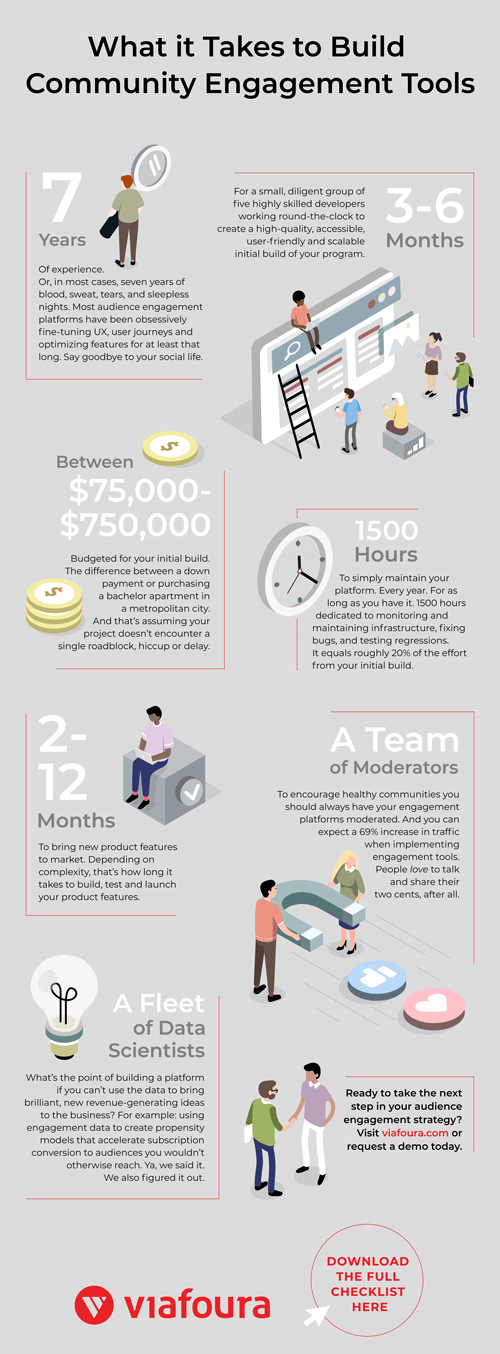With the decline of trust in social media advertising, media organizations are exploring new technologies — specifically on-site engagement tools that build audiences on their own platforms.
A recent survey by PEW Research Center has revealed that skepticism towards social media continues to grow. In fact, according to the survey, “six-in-ten (62%) [Americans] say social media companies have too much control over the mix of news that people see.”
Media organizations are growing frustrated as big tech companies change their algorithms, fail to moderate toxicity properly and exercise complete control over how often and where their content is appearing. It’s no surprise that media organizations are ready for a change.
Businesses have, nevertheless, started shifting away from advertising revenue and towards subscription-driven models, where visitors are nurtured and grown into a thriving digital community.
And what better way to grow a community than with on-site engagement tools?
If you’ve invested in tools to help build a thriving community on your own platforms, don’t celebrate just yet — this is only the beginning of your engagement solution. You’re probably wondering what your next steps should be. Well, we’re about to give you the low-down on how to make the most of your engagement tools:
1. Define Your Community Engagement Goals
Every good audience engagement solution starts with a plan. So the first step, even before you purchased your tools, is to clearly define your community engagement goals.
Do you want to drive ad loads by maximizing pageviews? Increase depth of visit or visit frequency (a.k.a. loyalty)? Or perhaps you’re aiming to drive registration or subscription conversions and even prevent churn.
No matter what you’re trying to accomplish, you need to return to the basics and set some relevant goals. After all, the way you implement and measure audience engagement will be greatly influenced by what you’re aiming to achieve.
Our industry experts strongly advise against using on-site engagement tools without a clear strategy and goal. Otherwise, the major benefits of these tools may slip away, right between your fingers.
2. Ensure Your Community Guidelines Are in Tip-Top Shape
By opening up your platforms to engagement, you’ll learn more about your users and improve how invested they are in your brand. However, the onus to protect these engaging spaces from trolls and toxic behavior falls on you.
In order to properly protect your brand and encourage participation, your community needs to know what rules they should be following. And you need to know how strict any moderation should be. For instance, sports news organizations may want weaker moderation to allow for friendly debates, but still prevent offensive discourse and harassment. The choice is ultimately yours and will differ between companies.
By investing some effort into carefully crafting community guidelines and enforcing comment moderation, you can expect to see more revenue funneling into your company’s pockets as users become hooked.
Not sure where to begin? You can find community guideline-setting best practices here.
3. Perfect Your Conversion Strategy
After you’ve set goals for your on-site engagement tools and have your community guidelines in place, it’s time to establish the ultimate conversion strategy for your platform.
Work with your paywall and engagement tool providers to come up with and implement a conversion strategy that best suits your business model.
Whether you’re looking to convert visitors to registrants, members or subscribers, you need to decide what type of conversion message should pop up and how strict your paywall (if any) should be. You may also want to consider having your engagement tools feed highly engaged visitors as well as churn-ready subscribers to your paywall.
Creating a conversion strategy can be complex and may require some trial and error on your part; however, if done correctly, it will absolutely pay off in the long run.
Bloomberg Media, for instance, has seen tremendous success with its conversion strategy in the past two years, which has tightened a paywall using 22 criteria. The media organization now credits two-thirds of their subscribers to website visits alone.
4. Watch the Metrics to Keep Visitors Engaged
You’re no stranger to your platform’s analytics, we get it. That said, there are some key metrics you can get from your engagement tools worth keeping an eye on. Media organizations that don’t pay attention to factors like active user engagement and civility trends are missing out on a big opportunity to keep their communities engaged in a valuable way.
Rather than turning to social media for audience data, dig deeper into the information from your own platforms so that you can give people exactly what they want, when they’re ready for it.
Your engagement data will help you to identify how well or poorly your content is being perceived by your audience. You can also re-engage inactive subscribers with personalized, special offers based on insights from your first-party data.
Keep in mind that it can cost up to five times the amount of resources to attract new consumers than keep old ones.
As stated by the VP of audience development and analytics at Condé Nast, “it is always much easier to retain somebody than to bring in someone new, because they already value and trust you, and they want to engage with your content and your product, versus trying to convince somebody why they should subscribe or join.”
5. Highlight Examples of Top Engagement/Community Members
Strengthen relationships directly within your online community by highlighting good behavior on your platform.
You can try rewarding users with special badges that identify them as trusted community members. Or, showcase top comments on threads to help your users feel valued. This will help you to build trust and interest within your community.
Once you have your engagement tools, your platform will transform into a place for people to interact with trustworthy content, establish relationships with others and become important community members.
Yet, the most effective on-site engagement tools can’t be left to run on their own. They need to be backed by strategy, community guidelines and actionable insights. Planning, testing and refining your business’ audience engagement process must be a constant effort. That way, your business can evolve as the industry evolves.
RELATED: Your Guide to Building and Engaging an Online Community



